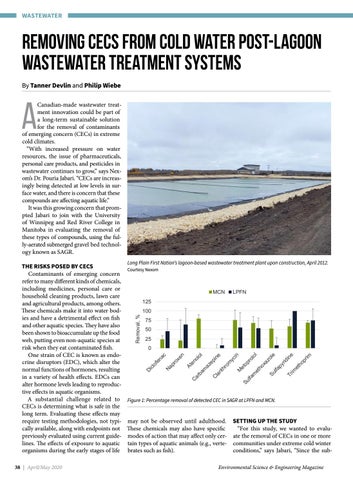WASTEWATER
Removing CECs from cold water post-lagoon wastewater treatment systems By Tanner Devlin and Philip Wiebe
A
Canadian-made wastewater treatment innovation could be part of a long-term sustainable solution for the removal of contaminants of emerging concern (CECs) in extreme cold climates. “With increased pressure on water resources, the issue of pharmaceuticals, personal care products, and pesticides in wastewater continues to grow,” says Nexom’s Dr. Pouria Jabari. “CECs are increasingly being detected at low levels in surface water, and there is concern that these compounds are affecting aquatic life.” It was this growing concern that prom- pted Jabari to join with the University of Winnipeg and Red River College in Manitoba in evaluating the removal of these types of compounds, using the fully-aerated submerged gravel bed technology known as SAGR.
38 | April/May 2020
Long Plain First Nation’s lagoon-based wastewater treatment plant upon construction, April 2012. Courtesy Nexom
MCN
LPFN
125 100 Removal, %
75 50 25 At en C ol ar ol ba m az ep C in la e rit hr om yc in M et Su op ro lfa lo m l et ho xa zo Su le lfa py rid in Tr e im et ho pr im
en
N ap ro x
en ac
0 D ic lo f
THE RISKS POSED BY CECS Contaminants of emerging concern refer to many different kinds of chemicals, including medicines, personal care or household cleaning products, lawn care and agricultural products, among others. These chemicals make it into water bodies and have a detrimental effect on fish and other aquatic species. They have also been shown to bioaccumulate up the food web, putting even non-aquatic species at risk when they eat contaminated fish. One strain of CEC is known as endocrine disruptors (EDC), which alter the normal functions of hormones, resulting in a variety of health effects. EDCs can alter hormone levels leading to reproductive effects in aquatic organisms. A substantial challenge related to CECs is determining what is safe in the long term. Evaluating these effects may require testing methodologies, not typically available, along with endpoints not previously evaluated using current guidelines. The effects of exposure to aquatic organisms during the early stages of life
Figure Percentage removal of detected CECat inLPFN SAGR LPFN and MCN. Figure 1: 1: Percentage removal of detected CEC in SAGR andatMCN.
may not be observed until adulthood. SETTING UP THE STUDY “Of the 32 known target CECs, only eight were detected in the SAGR influent on both sites,” say These chemicals may also have specific “For this study, we wanted to evaluJabari, adding that atenolol was detected only at MCN. Out of those eight, he says, testing of the modes of action that may affect only cer- ate the removal of CECs in one or more effluent showed the SAGR had(e.g., removed CECsunder at different levels, tain types of aquatic animals verte-the detected communities extreme coldranging winterfrom low high treatment. brates such as fish). conditions,” says Jabari, “Since the sub-
“We see different levels of treatment for different CECs, because of the speed that each chemical Science & Engineeringwas Magazine breaks down in water,” says Jabari. TheEnvironmental anti-seizure drug carbamazepine not well-removed b SAGR at either site, possibly due to its low biodegradation rate at low temperatures. By comparis
